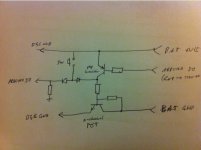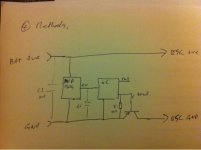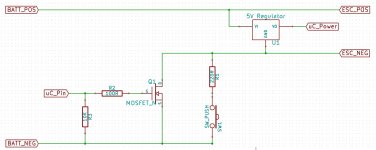Okay I am debating what features my new control PCB will have, so I thought I would document it here so others can give me their opinions.
So I am making a custom PCB to do all the smart control of the RC ESC. Including:
- power limitting
- throttle interface
- throttle ramp rate control for smooth drive ngagemnt/disengagement
- CA style display
- EU/AU/US legal modes etc.
What I am debating at the moment is whether I implement a soft on/off switch. The idea is that the bike will put itself to sleep when the speed/throttle hasn't changed for xx mins. Then you just press a button to wake it up. The main purpose is to protect the batteries from idle currents, as most RC ESCs and the controller I plan on using do not have an on/off switch, so the only option to turn it off is to physcially disconnect the battery.
So how much current are we talking about:
- YEP 150Amp ESC = 10 mA
- Tz85Amp ESC = 50 mA
- Current Generation Brain Box = 30mA
So @ 40mA * 24 hours = ~1Ah in a day.

Not good
Option 1
Originally I had planned a soft on/off based on
this circuit. Which worked nicely with the low power on/off switch of the Tz85A ESC.
But now that I have no on/off switch on the YEP 150Amp ESC, I have to cut the main power. So rather than a little transistors I have to have bigger FETs I guess. These will have to be able to handle 500-1000w at 5-6s, so lets say 50 amp continuous. But the power flows through the p-channel transistor, which in
FET land means high Rds-on. In the order of 10+ mOhm.

That won't work. So I need to modify the circuit to work with an n-channel fet cutting the power, so I can use a fet more like
this.
Or.......
Option 2
Go for something more like Methods Solid State Relay, but run the LDO straight off the main battery pack. A 24v capable LDO like the
MCP1804 has a queiscent crrent of 150uA, and with some
Arduino magic, we can get the uC current really low too.
So... I need to either modify Option 1 to have an n-channel fet to cut the power, while still allowiing my button state to be detected by my 5v arduino. Thus should result in having just the fet leakage current of 20uA to deal with.
Or... get fancy with my arduino and trust in Methods design before he has even prototyped it, and take up a few extra IOs from the arduino to drive the FETs.
So what do people think? Can someone smarter than me modify the Option schematic to suit my needs?




